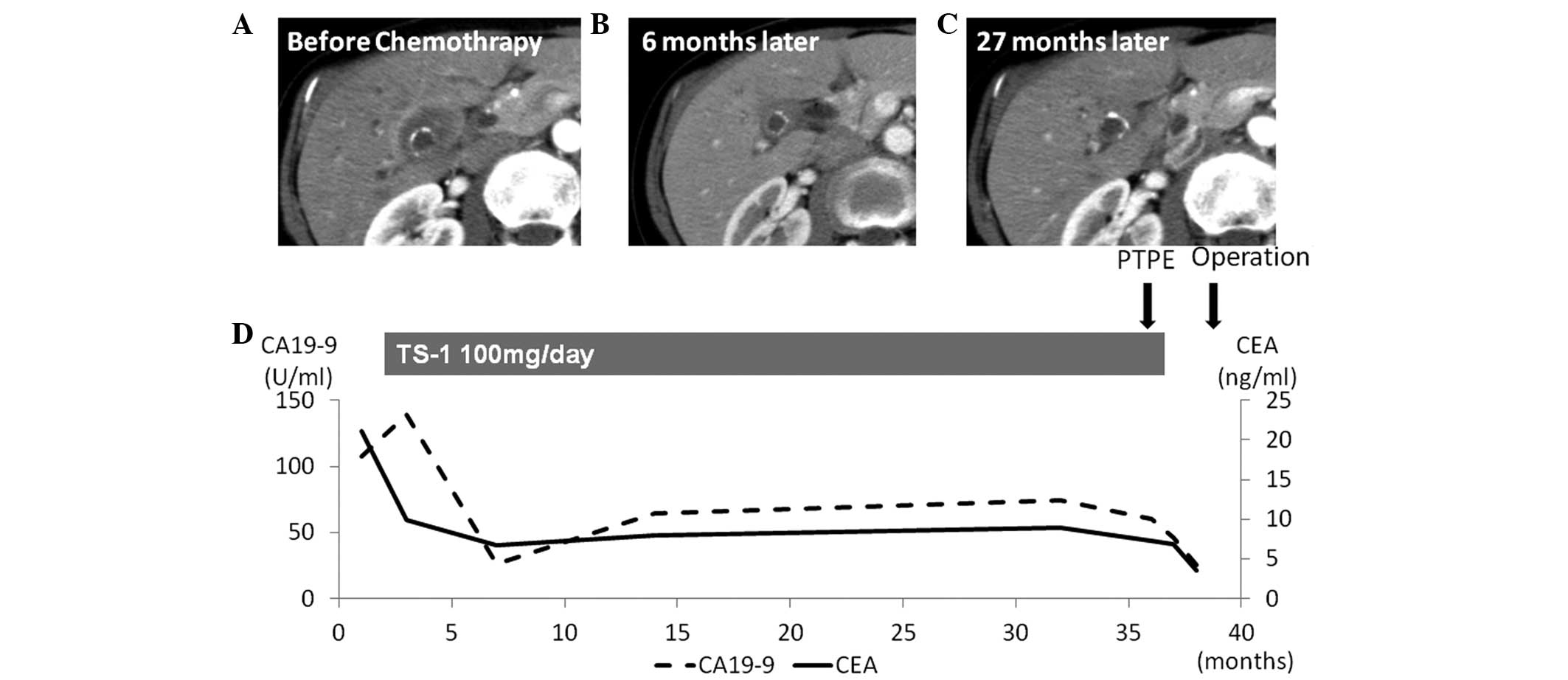|
1
|
Zhu AX, Hong TS, Hezel AF and Kooby DA:
Current management of gallbladder carcinoma. Oncologist.
15:168–181. 2010.
|
|
2
|
Glimelius B, Hoffman K, Sjödén PO, et al:
Chemotherapy improves survival and quality of life in advanced
pancreatic and biliary cancer. Ann Oncol. 7:593–600. 1996.
|
|
3
|
Ishikawa T, Horimi T, Shima Y, et al:
Evaluation of aggressive surgical treatment for advanced carcinoma
of the gallbladder. J Hepatobiliary Pancreat Surg. 10:233–238.
2003.
|
|
4
|
Shirasaka T, Shimamato Y, Ohshimo H, et
al: Development of a novel form of an oral 5-fluorouracil
derivative (S-1) directed to the potentiation of the tumor
selective cytotoxicity of 5-fluorouracil by two biochemical
modulators. Anticancer Drugs. 7:548–557. 1996.
|
|
5
|
Boku N, Yamamoto S, Fukuda H, et al:
Gastrointestinal Oncology Study Group of the Japan Clinical
Oncology Group: Fluorouracil versus combination of irinotecan plus
cisplatin versus S-1 in metastatic gastric cancer: a randomised
phase 3 study. Lancet Oncol. 10:1063–1069. 2009.
|
|
6
|
Koizumi W, Narahara H, Hara T, et al: S-1
plus cisplatin versus S-1 alone for first-line treatment of
advanced gastric cancer (SPIRITS trial): a phase III trial. Lancet
Oncol. 9:215–221. 2008.
|
|
7
|
Ueno H, Okusaka T, Ikeda M, Takezako Y and
Morizane C: Phase II study of S-1 in patients with advanced biliary
tract cancer. Br J Cancer. 91:1769–1774. 2004.
|
|
8
|
Van Triest B, Pinedo HM, Giaccone G and
Peters GJ: Downstream molecular determinants of response to
5-fluorouracil and antifolate thymidylate synthase inhibitors. Ann
Oncol. 2000 Apr;11(4): 385–91
|
|
9
|
Miyoshi Y, Uemura H, Ishiguro H, et al:
Expression of thymidylate synthase, dihydropyrimidine
dehydrogenase, thymidine phosphorylase, and orotate phosphoribosyl
transferase in prostate cancer. Prostate Cancer Prostatic Dis.
8:260–265. 2005.
|
|
10
|
Diasio RB and Lu Z: Dihydropyrimidine
dehydrogenase activity and fluorouracil chemotherapy. J Clin Oncol.
12:2239–2242. 1994.
|
|
11
|
Kuramochi H, Hayashi K, Uchida K, et al:
Vascular endothelial growth factor messenger RNA expression level
is preserved in liver metastases compared with corresponding
primary colorectal cancer. Clin Cancer Res. 12:29–33. 2006.
|
|
12
|
Manfredi S, Benhamiche AM, Isambert N, et
al: Trends in incidence and management of gallbladder carcinoma: a
population-based study in France. Cancer. 89:757–762. 2000.
|
|
13
|
Grobmyer SR, Lieberman MD and Daly JM:
Gallbladder cancer in the twentieth century: single institution’s
experience. World J Surg. 28:47–49. 2004.
|
|
14
|
Kitajima K, Kobayashi S, Shiba H, et al:
Successful treatment of advanced gallbladder cancer with an
anticancer drug S-1: assessment based on intratumoral gene. Int J
Clin Oncol. 13:545–551. 2008.
|
|
15
|
Bismuth H, Adam R, Lévi F, et al:
Resection of nonresectable liver metastases from colorectal cancer
after neoadjuvant chemotherapy. Ann Surg. 224:509–520. 1996.
|
|
16
|
Alberts SR, Horvath WL, Sternfeld WC, et
al: Oxaliplatin, fluorouracil, and leucovorin for patients with
unresectable liver-only metastases from colorectal cancer: a North
Central Cancer Treatment Group phase II study. J Clin Oncol.
23:9243–9249. 2005.
|
|
17
|
Adam R, Avisar E, Ariche A, et al:
Five-year survival following hepatic resection after neoadjuvant
therapy for nonresectable colorectal. Ann Surg Oncol. 8:347–353.
2001.
|
|
18
|
Morimoto H, Ajiki T, Takase S, et al:
Resection of gallbladder cancer with hepatic metastasis after
chemotherapy with gemcitabine. J Hepatobiliary Pancreat Surg.
15:655–658. 2008.
|
|
19
|
Takita M, Iwasaki E, Hatogai K, et al:
Advanced gallbladder cancer that showed complete response to
gemcitabine plus S-1 chemotherapy. Nihon Shokakibyo Gakkai Zasshi.
108:1263–1270. 2011.(in Japanese).
|
|
20
|
Soong R, Shah N, Salto-Tellez M, et al:
Prognostic significance of thymidylate synthase, dihydropyrimidine
dehydrogenase and thymidine phosphorylase protein expression in
colorectal cancer patients treated with or without
5-fluorouracil-based chemotherapy. Ann Oncol. 19:915–919. 2008.
|













